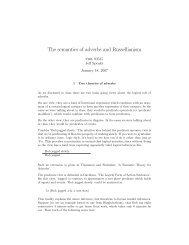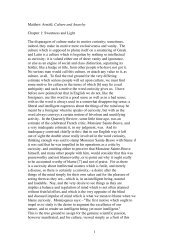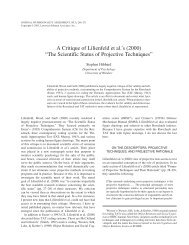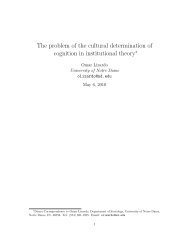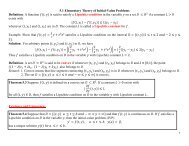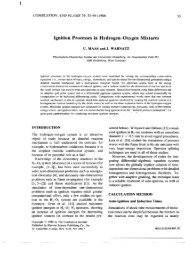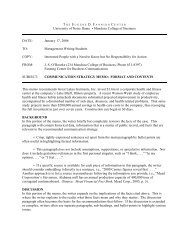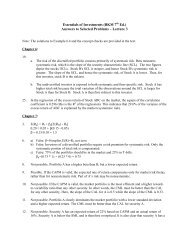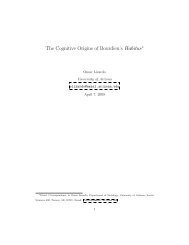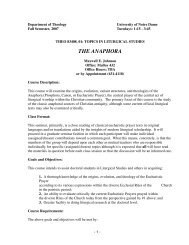So consider the game below. If the row player used b this round, the column player’sbest-response would have been z for a payoff of 3. If the column player’s strategies aredecided by best-response dynamics, then, we’d predict he should play z <strong>in</strong> the next round.x y za 3,3 1,2 1,0b 0,1 2,2 3,3c 1,2 -1,-1 4,4(a). F<strong>in</strong>d all Nash equilibria.(b). Show that if you start at (b,y), play eventually reaches (c,z) <strong>and</strong> stays there permanently.Is this a Nash equilibrium?(c). Show that if you start at (a,z), the learn<strong>in</strong>g process never reaches a Nash equilibrium.(d). Is there any start<strong>in</strong>g po<strong>in</strong>t that converges to the Nash equilibrium at (a,x)? Why isthis a “fragile” Nash equilibrium under best-response dynamics, especially if players sometimesmake mistakes?(e). Show that if each player uses the same strategy twice, then their strategies form apure-strategy Nash equilibrium, <strong>and</strong> they will play those strategies <strong>in</strong> all future periods.(f). Is this a good model of learn<strong>in</strong>g or not? Expla<strong>in</strong> your answer (particularly tak<strong>in</strong>g youranswer to part (v) <strong>in</strong>to account).i. F<strong>in</strong>d all Nash equilibria. Show that if you start at (b,y), play converges to (c,z).Is this a Nash equilibrium?The Nash equilibria are underl<strong>in</strong>ed.Here is a map of how the game moves:(a,x) → (a,x)(a,y) → (b,x)(a,z) → (c,x)(b,x) → (a,z)(b,y) → (b,z)(b,z) → (c,z)(c,x) → (a,z)(c,y) → (b,z)(c,z) → (c,z)Thebestth<strong>in</strong>gtodoisdrawarrowsonthestrategicformshow<strong>in</strong>gtheabove<strong>in</strong>formation;this lets you visualize the dynamics.iii. Show that if you start at (a,z), the game never converges to an equilibrium.From the “map” above, (a,z) → (c,x) <strong>and</strong> (c,x) → (a,z), so the players bounce back<strong>and</strong> forth between those two profiles forever.iv. Is there any start<strong>in</strong>g po<strong>in</strong>t that converges to the Nash equilibrium at (a,x)?Why is this a “fragile” Nash equilibrium under best-response dynamics?Only (a,x). If you look at the map, no profile ends at (a,x) except (a,x) itself. Thismeans that unless the game starts there, the players will never f<strong>in</strong>d it, <strong>and</strong> if eitherplayer makes a mistake <strong>and</strong> does someth<strong>in</strong>g else, the game will never return to thisoutcome. Imag<strong>in</strong>e that the dynamics are like a ball roll<strong>in</strong>g on a bowl. If the bowl is6
ight-side up <strong>and</strong> you drop the ball <strong>in</strong>to the bowl, it will roll to the bottom <strong>and</strong> staythere. If you tweak the ball, it will return to the bottom. If you flip the bowl upsidedown, you can balance the ball exactly <strong>and</strong> it will stay there, but if you tweak it, it willroll away. That’s the difference between the Nash equilibrium <strong>in</strong> the upper-right corner<strong>and</strong> the lower-left corner.v. Show that if either player knew the other was us<strong>in</strong>g best-response dynamics,that player could “guide” the other player to the Nash equilibrium at (c,z).If the column player uses z twice, the row player will use c on the second round<strong>and</strong> they can stay at the “good” Nash equilibrium forever. If the row player uses ctwice, the column player will use z for sure on the second round <strong>and</strong> they can stay atthe “good” Nash equilibrium forever. This shows that if your opponent is us<strong>in</strong>g bestresponsedynamics, you probably don’t have an <strong>in</strong>centive to use best-responsedynamicsyourself.vi. Is this a good model of learn<strong>in</strong>g or not? Expla<strong>in</strong> your answer (particularlytak<strong>in</strong>g your answer to part (v) <strong>in</strong>to account).Yes: It <strong>in</strong>corporates feedback that players receive through their payoffs to makedecisions about future play. Normal game theory assumes that players “know” whatequilibrium they are us<strong>in</strong>g or can reason their way to a unique prediction, which isn’talways a good assumption. Here, the players update over time, <strong>and</strong> as long as we don’tend up <strong>in</strong> the cycle they converge fairly quickly to a Nash equilibrium anyway.No: In part iii, iv, <strong>and</strong> v, we see that players can end up <strong>in</strong> unrealistic situationsas a result of best-response dynamics, where real players would probably ab<strong>and</strong>on thatapproach<strong>and</strong>trysometh<strong>in</strong>gelse. Insteadofus<strong>in</strong>gaforward-look<strong>in</strong>g, deductiveapproachitreliesonabackward-look<strong>in</strong>g, <strong>in</strong>ductiveapproachthatisnotalwaysgo<strong>in</strong>gtoaccuratelypredict future play. Ideally, we’d like someth<strong>in</strong>g <strong>in</strong> the middle, but this seems toosimplistic.5b. The purpose of this question is to show that while the tools we have adopted (bestresponses,strategy dom<strong>in</strong>ance, iterated deletion of dom<strong>in</strong>ated strategies) are useful, thereare other ways to approach the material.Rather than focus on dom<strong>in</strong>ance, let’s try another idea, called “rationalizability”. Astrategy is rationalizable if it is a best-response to some profile of strategies your opponentscould use.(a). Write a mathematical def<strong>in</strong>ition for a rationalizable strategy similar to the def<strong>in</strong>itionof a dom<strong>in</strong>ant strategy, us<strong>in</strong>g the u i (s i ,s −i ) notation. It’s OK if you f<strong>in</strong>d this hard, or don’tth<strong>in</strong>k your answer is correct; this is just an exercise <strong>in</strong> th<strong>in</strong>k<strong>in</strong>g <strong>in</strong> alternative ways aboutplayers, games <strong>and</strong> behavior.(b). Write out a process similar to iterated deletion of strictly dom<strong>in</strong>ated strategies called‘iterated deletion of unrationalizable strategies’. Use it to solve the follow<strong>in</strong>g game:7
- Page 1 and 2: Problem Set 11. Games in Strategic
- Page 3 and 4: The Nash equilibrium is (A,A), sinc
- Page 5: (1) CL RU 2,2,3 1,1,2B D 1,3,4 1,4,
- Page 9 and 10: the strategy d is a best response t
- Page 11: The usual profiles (U,L) and (D,R)



